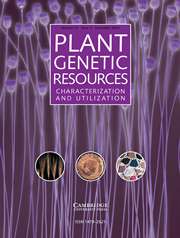Article contents
Mapping of QTLs for flood tolerance in rice using recombinant inbred lines of Indra and a new plant genetic resource AC 39416 A
Published online by Cambridge University Press: 22 March 2023
Abstract
Rice crop is affected by different types of floods at different stages of the crop cycle. Constant efforts of researchers resulted in the development of rice varieties for anaerobic germination, flash floods and stagnant flooding by both conventional and molecular breeding approaches. Detection of QTLs for different types of floods in new genetic source (AC39416A) is needed to combat adverse effects of climate change. Present investigation was carried out to identify QTLs for flood tolerance using recombinant inbred lines derived from Indra and AC39416A. QTL mapping resulted in identification of QTLs, qAG3.1 on chromosome 3 for anaerobic germination and qSF10.1 on chromosome 10 for plant survival % under stagnant flooding. These QTLs explain 59.08 and 13.21% of phenotypic variance respectively. Two candidate genes were identified in qAG3.1 region, LOC_Os03g42130 gibberellin 20 oxidase2 and LOC_Os03g44170 glutathione S-transferase. The underlying mechanism might be the inhibition of gibberellic acid synthesis and thereby protecting seedlings from oxidative stress under anoxia condition. Genomic region of qSF10.1 revealed LOC_Os10g35020 glycosyltransferase and LOC_Os10g35050 aquaporin protein loci, which might be responsible for adaptive mechanism for plant survival % under stagnant flooding. This indicates that the new genetic resource AC39416A has an ability to adopt to different types of flood tolerance in response to environmental stress. Unveiling physiological and molecular mechanisms for flood tolerance in AC39416A using advanced omics studies would help in precise genomic selections for sustained production in flood-prone areas.
Information
- Type
- Research Article
- Information
- Copyright
- Copyright © The Author(s), 2023. Published by Cambridge University Press on behalf of NIAB
References
- 2
- Cited by

